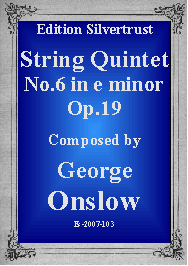Presents
George Onslow
String Quintet No.6 in e minor, Op.19-New Edition
For 2 Violins, Viola & 2 Cellos or 2 Violins 2 Violas & Cello
 Schumann
and Mendelssohn ranked Onslow's chamber music with that of Mozart, Beethoven and
Haydn. As such, George Onslow (1784-1853), certainly illustrates the fickleness
of fame. During his
lifetime, Onslow, above all, was known as the composer of string quintets for 2
violins, viola and 2 cellos. With the exception of Boccherini, all of the other
major composers before him, including Mozart and Beethoven, wrote string quintets for 2
violins, 2 violas and cello. (Schubert's great work remained undiscovered until
1850 and
unknown for another decade after that.)
Schumann
and Mendelssohn ranked Onslow's chamber music with that of Mozart, Beethoven and
Haydn. As such, George Onslow (1784-1853), certainly illustrates the fickleness
of fame. During his
lifetime, Onslow, above all, was known as the composer of string quintets for 2
violins, viola and 2 cellos. With the exception of Boccherini, all of the other
major composers before him, including Mozart and Beethoven, wrote string quintets for 2
violins, 2 violas and cello. (Schubert's great work remained undiscovered until
1850 and
unknown for another decade after that.)
He was born the son of an English father and French mother. His 36 string quartets and 34 string quintets were, during his own lifetime and up to the end of the 19th century, held in the highest regard, particularly in Germany, Austria and England where he was regularly placed in the front rank of composers. His work was admired by both Beethoven and Schubert, the latter modeling his own 2 cello quintet (D.956) on those of Onslow and not, as is so often claimed, on those of Boccherini. As tastes changed after the First World War, his music, along with that of so many other fine composers, fell into oblivion and up until 1984, the bicentennial of his birth, he remained virtually unknown. Since then, his music, to the delight of players and listeners alike, is slowly being rediscovered, played and recorded. Onslow’s writing was unique in that he was successfully able to merge the drama of the opera into the chamber music idiom perfected by the Vienna masters.
Although the first 3 of Onslow's string quintets were for the standard 2 violins, 2 violas and cello, thereafter, his quintets, with the exception of his last three, were for 2 violins 1 viola and 2 cellos. However, starting with his fourth quintet, Onslow usually provided alternative viola parts for the first cello and, with his 10th quintet, bass parts to replace the second cello.
String Quintet No.6, Op.19 was published in 1822 and helped to make Onslow's reputation throughout Germany and Austria, where it became very popular. The opening Allegro, after a brief introduction, begins with a march-like theme. The somewhat sad second subject is more lyrical but retains a hint of the march. This movement is a good example of Onslow's unmatched ability to combine martial themes with more lyrical subjects. The second movement, a Minuetto, shares the same somber mood as the preceding Allegro. The flowing theme, passed from voice to voice, gives off the aura of a trickling stream. The slower trio section, though more lyrical, does little to dissolve the hovering clouds. The exciting finale, also an Allegro, begins softly with a nervous, almost frantic theme. Tension is built by use of a more lyrical subject against the pulsating rhythms in the other voices.
This quintet is characteristic of Onslow's early middle period and is certainly one of the best string quintets to be written up to this time (1821). Our edition (the first since the late 19 century) has been edited by Skyler Silvertrust* and has been entirely reset. Of particular importance is the fact that it does not use the "false treble clef" in the first cello part which appears extensively in all of the other previous editions and which has always been a problem for cellists. Instead, we have substituted the bass and tenor clefs which greatly improves the readability. Like all of our editions, this quartet is printed on top grade paper with an ornate cover with biographical information about the composer.
*Skyler Silvertrust, a violinist, is a recognized Onslow specialist. He is extremely familiar with the Onslow quartets, having performed most of them, and is mentioned by the author of The String Quartets of George Onslow in the acknowledgement section as being one of the performers who helped the author with his work.